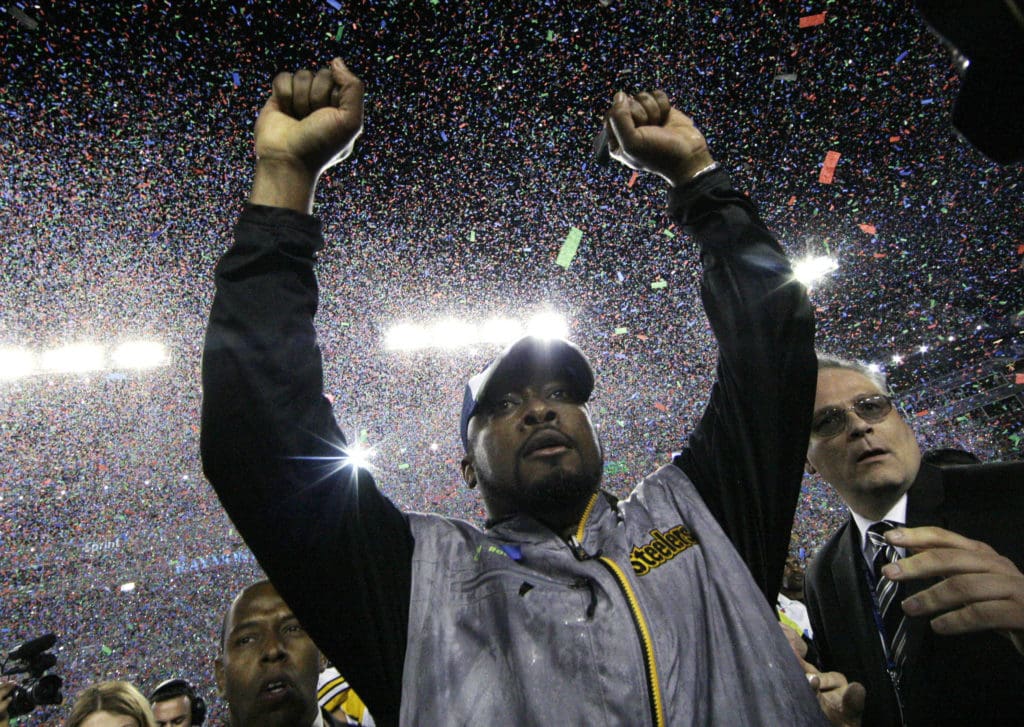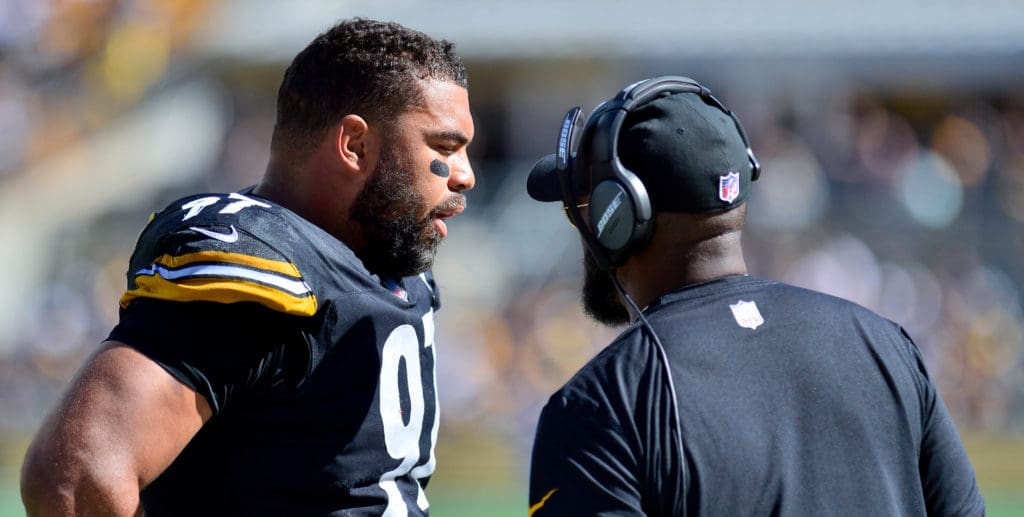Saunders: The Truth about Mike Tomlin and His Streak

PITTSBURGH — Pittsburgh Steelers head coach Mike Tomlin extended his streak of not having a losing season to 16 seasons with the Steelers finishing 9-8 in 2022 thanks to their season-closing 28-14 win over the Cleveland Browns.
That streak has become a lightning rod for many in the Steelers fanbase, who see the celebration of it as a tacit acceptance of the team having not won a playoff game since 2016 and now being 14 years past its last Super Bowl win.
Streaks such as Tomlin’s are not common. His is the longest to start a career in NFL history. He is by far the most-tenured coach to never have a losing season. And the Steelers’ team record, which dates back to 2003, is now tied for the second-longest in league history.
Clearly, they’re doing something right. But that doesn’t mean that all of the streak should be celebrated, either.
Take it akin to a Major League Baseball player. If Pittsburgh Pirates outfielder Bryan Reynolds had a 16-game hitting streak, that might sound impressive. If Reynolds was exactly 1 for 5 in all of those games, they were all singles, and he was batting .200 on the season, it might look less impressive. If you consider that Reynolds was an All-Star with high expectations, then it starts to look a lot less impressive.
But now what if Reynolds had some good games in there, some 3-for-5s and 4-for-5s, with some home runs and a bunch of RBIs? What if he had a 1-for-5 game with a single, but he drove in the game-winning run with it? That would look a lot different.
The streak itself doesn’t provide enough context to tell us whether Reynolds is playing good, bad or average. At the end of the day, hitting streaks are just trivia. They’re something to talk about and maybe even celebrate when they reach a certain point, but they don’t mean much of anything when it comes to evaluating the talent or the productivity of the player involved.
It’s the same thing with Tomlin. Just saying that Tomlin hasn’t had a losing season in 16 years doesn’t really tell us a lot without additional context. So let’s find some.
For me, Tomlin’s streak needs to be divided into three distinct periods.

THE GLORY DAYS
From 2007 to 2011, Tomlin’s team won the AFC North three times, made the playoffs four times, won one Super Bowl and made it to another. Frankly, at that point, nobody gave a shit about his streak. But maybe we should have.
It’s very difficult for teams that play all those extra games to make it to the Super Bowl, then have to overpay to keep their own free agents due to the additional exposure, and pick at the very end of the draft, to stay consistently good.
Look at what happened to last year’s Super Bowl champions. The Los Angeles Rams finished 5-12. The 2019 San Francisco 49ers lost the Super Bowl and went 6-10 the next year. The same thing for the 2015-16 Carolina Panthers. The Chicago Bears followed a Super Bowl loss with a 7-9 2007.
The Super Bowl hangover is real, not just for the winning team, but for the losing team, too. Tomlin’s Steelers went 9-7 in 2009 after his Super Bowl win and went 12-4 in 2011 after his Super Bowl loss. That’s better than most teams do in those circumstances and some credit is probably due for him never letting those talented teams slip.
Also, when you win the Super Bowl and go to another in such a short span, it doesn’t really matter what else you do, it’s pretty clear that you’re doing a bunch of things right and you don’t need any further validation from silly streaks. Next.

THE KILLER B’s
Then you have the middle portion of Tomlin’s tenure, when the team had dominant offensive talent in Ben Roethlisberger, Le’Veon Bell and Antonio Brown but won just three playoffs games from 2012 to 2018.
Over those seven years, the Steelers made one AFC Championship Game (a blowout by New England in 2016), won the division three times and made the playoffs four, but finished 8-8 twice and 9-6-1 once.
This is the time period when Tomlin’s streak grew to prominence. It’s also the time period that it meant the least. Those Steelers teams were good enough to win — or at least compete for — championships. There was some bad luck involved for all parties, with injuries to Bell (2014), Bell and Brown (2015), Bell (2016) and Ryan Shazier (2017) all factoring into the team’s playoff losses.
But injuries are part of the deal in the NFL, and the Steelers were unable to overcome them in a meaningful way. This was Bryan Reynolds with a bunch of 1 for 5 games with singles. The streak stayed alive, but it was not something anyone wanted to be hanging their hat on.
However, the more we’ve seen from Brown since his Steelers tenure has ended makes it seem more like Tomlin held together a pretty volatile situation about as best he could, and while the team never reached its ultimate goals on the field, Brown and Bell co-existed under the Steelers umbrella together far longer than either of them did anything productive outside of it.

A NEW ERA
Now, we come to the last four seasons. The Steelers have played two of those without Roethlisberger and two with a post-injury version of Roethlisberger that was seriously lacking when compared to the perennial Pro Bowler of before. The Steelers also went through a near complete turnover of the offense around Ben. As the team ends the 2022 season, the longest-tenured starter on the offensive side of the ball is tackle Chuks Okorafor, who goes only back to 2018.
These Steelers teams have not been overwhelmingly talented. They have been deeply flawed units that still found a way to be above-average. This isn’t Bryan Reynolds on a streak of going 1 for 5 with a single. It’s Josh VanMeter.
Sidebar: VanMeter signed a minor-league contract with the Brewers and it feels like the chance of him getting called up and beating the Pirates in a deeply stupid game at whatever they’re calling Miller Park these days is near 100%.
Anyway, I’m not saying this slightly above-mediocre stretch needs to be celebrated. But let’s take note of what Tomlin has been working with and acknowledge that it has taken good coaching to keep it alive.
Something else has happened recently. As the streak has gone on, and people have talked about it, Tomlin has been very steadfast in saying that it means very little to him. But that’s not the case with his players. They seem to care a lot about making sure that they’re not the team that causes Tomlin to lose his streak. And that’s pretty unquestionably a good thing.
“It was probably more important to them as a subject matter, obviously, than it was to me,” Tomlin said Monday. “I’m appreciative of that, the relationship that I have with them that makes it important to them. But my agenda is getting in the single-elimination tournament and pursuing the confetti game and winning it. That agenda will never change. …
“Talking about accolades and trivial things and streaks and things of that nature, if it’s not useful to me in terms of assessing our next battles, then I don’t spend a lot of time thinking about it or focusing on it.”
So what is the nature of Tomlin’s streak? Is it good? Bad? Historic? Useless? The answer is all of the above, in parts.
It’s a piece of trivia that some people care about (the players, some fans) and others don’t (Tomlin, other fans), but when you search for deeper meaning, it reveals both positives and negatives about the 16-year tenure of the Pittsburgh Steelers head coach.
I’ll close with this. It’s mostly wrong to use a streak of non-losing seasons as a crutch to prop up Tomlin’s shortcomings. It’s also mostly wrong to dismiss it completely.
Tomlin is far from a perfect coach. But he’s been a very good coach for a very long time, and that is greatness in its own way. I haven’t done much of anything for 16 consecutive years, let alone be one of the best in the world at what I do.
When it comes time for the Pro Football Hall of Fame to characterize Mike Tomlin’s contributions to the game, the discussion will be a short one. How many losing seasons he has along the way will not be a part of the conversation.
